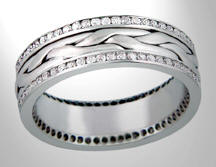950 Palladium: Manufacturing Methods
Palladium, long used as a luxurious jewelry metal, has recently experienced renewed interest largely due to its purity, natural white color and affordable pricing. Modern 950 palladium alloys containing various trace elements are superior to the palladium ruthenium alloys previously available for use in jewelry. The new 950 palladium alloys are:...
5 Minute Read
Palladium, long used as a luxurious jewelry metal, has recently experienced renewed interest largely due to its purity, natural white color and affordable pricing. Modern 950 palladium alloys containing various trace elements are superior to the palladium ruthenium alloys previously available for use in jewelry.
The new 950 palladium alloys are:
Pure
Palladium alloys formulated for jewelry predominately contain 95% palladium with the balance being ruthenium (another noble metal from the platinum group of metals, or PGM) and other trace elements. These trace elements are included in various combinations to create task specific alloys (i.e. for casting, fabricating, machining, etc.) for jewelry manufacturing processes.
Precious
Palladium is mined in only a few regions around the world. 7 million ounces of palladium were mined last year globally, compared to 7 million ounces of platinum and 80 million ounces of gold.
Naturally White
Palladium does not require rhodium plating to create or keep its bright, white appearance.
Comfortably Light
Palladium is nearly half the weight of platinum, opening up new avenues for jewelry designers focusing on white metals.
Durable and Wearable
Palladium is comparable to platinum when worn. It is strong, durable and tests have shown it outwears white gold.
Hypoallergenic
Palladium is not likely to cause skin allergies.
Workable
950 palladium alloys are desirably workable for jewelry design and manufacturing procedures. They are malleable, ductile, strong and durable and able to be worked in a variety of methods.
Here are some examples of pieces made with 950 palladium, using a variety of jewelry manufacturing methods.
The Process
When attempting to weld a joint with a torch, the best result comes from using the above process. Begin with a butt joint with beveled edges and a thin piece of 950 palladium sheet measuring 0.12mm in thickness (A). Use a vented torch tip and with gas and oxygen as the fuel source and heat the joint until the small piece melts into the shank (B). The result shows a micro-pitted surface (C) where the joint was heated. The surface distortion is removed by filing and burnishing.
Best Method
For the best results when sizing a ring, the use a standard butt joint and hard palladium solder. If hard palladium solder is not available, 1300 platinum solder will provide good results. Be sure and use platinum soldering techniques.
Palladium Jewelry Manufacturing: Frequently Asked Questions:
Can you torch weld 950Pd shanks when sizing a ring?
Yes, but its tricky. The main problem with welding palladium is oxygen absorption and the result is exhibits micro-pitting at the joint. (When molten, palladium dissolves large amounts of oxygen and will become a "homogenous liquid" in the sense that the elemental oxygen is mixed with the liquid palladium on an atomic level. When the metal solidifies, the oxygen wants to change phase back into a gas, and is released from the metal as just that, a gas. But the metal usually solidifies before all the gas can be evolved; hence gas porosity in the form of pits.
You assume all responsibility and risk for the use of the safety resources available on or through this web page. The International Gem Society LLC does not assume any liability for the materials, information and opinions provided on, or available through, this web page. No advice or information provided by this website shall create any warranty. Reliance on such advice, information or the content of this web page is solely at your own risk, including without limitation any safety guidelines, resources or precautions, or any other information related to safety that may be available on or through this web page. The International Gem Society LLC disclaims any liability for injury, death or damages resulting from the use thereof.
The All-In-One Jewelry Making Solution At Your Fingertips
When you join the Ganoksin community, you get the tools you need to take your work to the next level.
Trusted Jewelry Making Information & Techniques
Sign up to receive the latest articles, techniques, and inspirations with our free newsletter.



